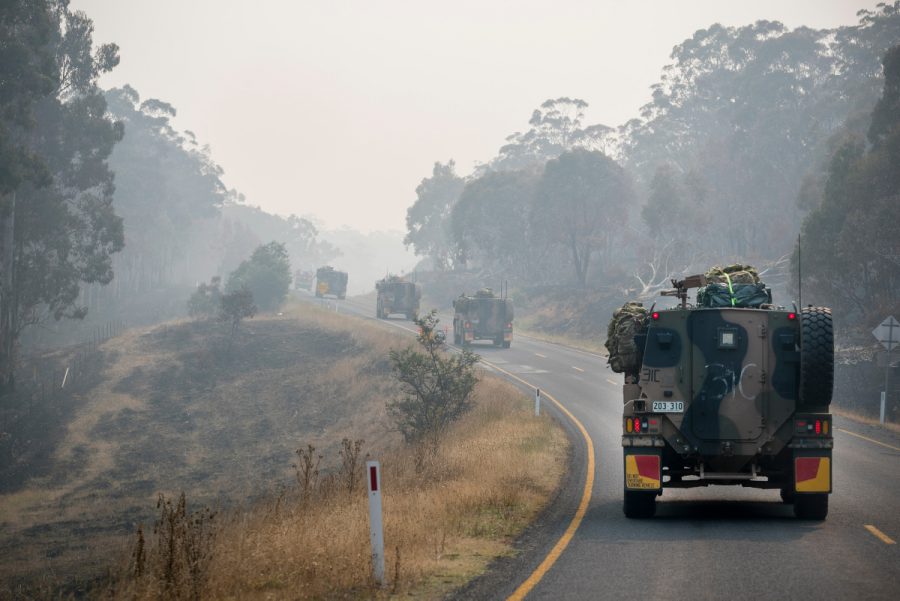Keeping the Australian Defence Force in the climate-change fight
Posted By Peter Layton on January 28, 2020 @ 12:51

A month on from my earlier post [1] on bringing the Australian Defence Force into the global warming fight, a lot has changed. Responding to the national bushfire catastrophe, the government has deployed more than 6,000 ADF personnel together with armoured vehicles, amphibious ships and transport aircraft. Even so, this is a stopgap measure. There remain the customary arguments opposing such ADF involvement, including that the ADF is solely a warfighting force [2] and there’s no money.
Such issues hinge on a compelling strategic narrative. Robert Glasser is right in pointing out [3] that we’re entering a new national security era in Australia. The problem is that global warming is wholly novel. There is no historical analogy to fall back on to give us cognitive assistance. However, we do know what it’s not: it is not a transnational criminal threat and neither is it a biohazard that governments everywhere cooperate on to defeat. It is, though, an almost totally externally generated threat and effectively forever.
The natural environment will now always be in a state of constant change. There will be no ‘new normal’. It’s not sufficient to address the problem by outsourcing through a regularly tendered contract. Instead, it needs an organisation that can constantly learn, that is flexible and adaptable, that is sovereign, that is always available and that accepts a real risk of death and injury. That sounds a lot like the ADF.
In my earlier post I proposed an additional 5,000 ADF personnel assigned to limiting the impact of global-warming-related events such as floods, megafires, cyclones and severe storms. Today’s ADF is regularly diverted from preparing for warfighting by the steadily rising demands [4] for humanitarian assistance and disaster relief (HADR; in the military, you know things are serious when there’s an acronym for it).
The ADF is now frequently involved in offshore HADR. For example, 1,000 ADF personnel were sent to Fiji after Cyclone Winston. A fortnight ago, at the height of our bushfire crisis, two cyclones passed through [5] the Fijian islands. They were smaller than Winston’s category 5, but indicate that the New Zealand Defence Force’s fears in 2017 of multiple disasters happening simultaneously are real. If the ADF needed to respond now to a major offshore disaster, it would stretch resources thin [6].
The ADF has 2,000 personnel deployed, most in the greater Middle East and on border patrol. To keep these deployments going, the rule of three applies. There are 2,000 getting ready to go and 2,000 just back. So 6,000 are actually committed. With 6,000+ on bushfire duties [7] (including around 2,500 reservists), that’s over 12,000 ADF personnel on operations. They are not preparing for their possible warfighting tasks; their skills are indeed dissipating.
An extra 5,000 personnel would allow the warfighting part of the ADF to get on and become good at what it needs to. Crucially, the extra 5,000 would professionalise HADR, including participating on the frequent international HADR exercises—which again don’t build warfighting skills.
Today, we have the bizarre situation where the (normally) unpaid volunteers at the bushfire front line are being supported by the salaried professionals of the ADF. It should be the other way around. Australia’s disaster response needs to be from professionals first and mainly, complemented by unpaid volunteers as appropriate.
Professionalisation would also mean having the right equipment. It’s not just the apocryphal stories [8] of crowd funding by the Rural Fire Service to get protective breathing equipment. The National Aerial Firefighting Centre [9] is a fine coordination hub, but it can only coordinate what it has. Getting firefighting aircraft quickly, when Australia really wants them, is harder than it sounds [10]. A professional ADF response to global-warming-related disasters would come with proper equipment and be properly trained.
However, all of that would require funding. A quick division of the defence budget by the 100,000 or so personnel it supports, including full-time staff, reservists, contractors and consultants, suggests 5,000 full-time-equivalent positions might cost, say, $2 billion annually, or around 5% of the defence budget. By comparison, the 12 new submarines will cost about $80 billion [11] to buy, or some 40 years of global warming disaster-related relief. If Australia can afford the submarines, Australia can afford a professional HADR group within defence. It’s just a matter of priorities.
Today, there is disappointment [12] at the limited resources available to defend towns from extensive damage. Having insufficient resources constrains what can be done and inevitably some lose out. Global warming may be an external threat Australia can’t solve, but lack of resources is an issue we could. More resources equal better outcomes; much more resources, much better outcomes.
Let’s imagine all this happens. When fires, floods, cyclones or severe storms loom there will now be adequate resources at hand to deal with the impacts. A well-equipped, professional force will have the capacity to be significantly more ambitious in trying to limit damage. Right now, we’re trying to figure out what can be done with the limited resources available. Maybe the right question is, if we had enough resources what could be done?
As global warming deepens, we need to do better. Keeping the ADF in the fight is one part of the solution.
Article printed from The Strategist: https://www.aspistrategist.org.au
URL to article: https://www.aspistrategist.org.au/keeping-the-australian-defence-force-in-the-climate-change-fight/
URLs in this post:
[1] my earlier post: https://www.aspistrategist.org.au/bringing-the-defence-force-into-australias-climate-change-fight/
[2] solely a warfighting force: https://www.aspistrategist.org.au/fighting-fires-is-not-the-australian-defence-forces-job/
[3] right in pointing out: https://www.aspistrategist.org.au/preparing-for-the-era-of-disasters/
[4] steadily rising demands: https://dfat.gov.au/aid/topics/investment-priorities/building-resilience/humanitarian-preparedness-and-response/Pages/humanitarian-prepraredness-and-response.aspx
[5] passed through: https://www.theguardian.com/world/2020/jan/17/fiji-calls-for-urgent-action-on-climate-crisis-as-second-cyclone-hits-in-three-weeks
[6] stretch resources thin: https://www.abc.net.au/news/2019-09-25/australian-defence-force-angus-campbell-climate-change-speech/11543464
[7] 6,000+ on bushfire duties: https://news.defence.gov.au/national/operation-bushfire-assist-2019-2020
[8] apocryphal stories: https://www.theguardian.com/australia-news/2019/dec/12/volunteer-firefighters-in-australia-warned-not-to-crowdfund-for-equipment
[9] National Aerial Firefighting Centre: http://www.nafc.org.au/
[10] harder than it sounds: https://www.abc.net.au/news/2020-01-16/bushfire-fighting-planes-unable-to-get-to-australia-from-canada/11871384
[11] about $80 billion: https://www.smh.com.au/politics/federal/submarine-fleet-tipped-to-cost-225b-to-build-and-maintain-20191129-p53fds.html
[12] disappointment: https://10daily.com.au/news/australia/la200101mizwt/food-petrol-shortages-as-residents-brace-for-more-bushfire-danger-20200101
Click here to print.